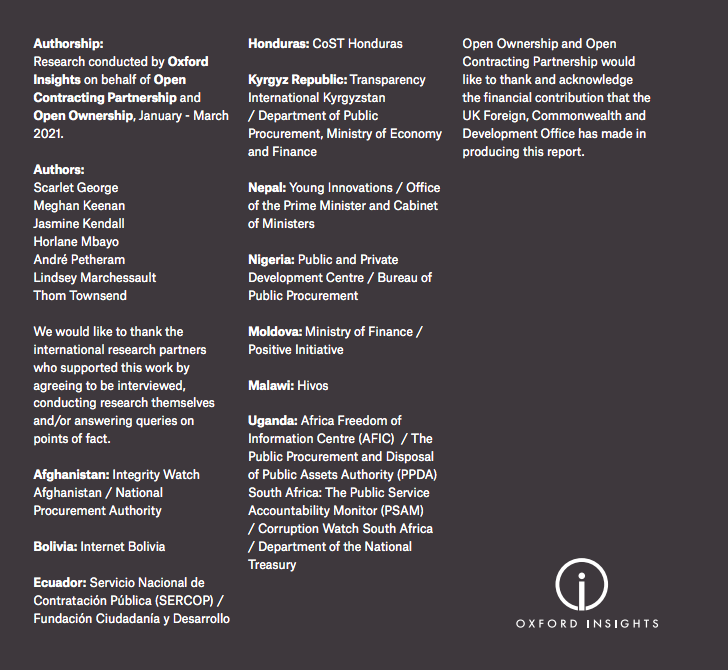Integrity in IMF COVID-19 financing
Executive summary
As economic crises followed the spread of the COVID-19 pandemic in the early months of 2020, many governments appealed to the International Monetary Fund (IMF) for financial support. The IMF released funds under emergency financing instruments like the Rapid Credit Facility (RCF). These involved only limited conditionality. [1]
Governments were asked to make commitments to a range of policies and safeguards before disbursement. These commitments included plans to introduce elements of procurement and beneficial ownership transparency.
Between January and March 2021, Oxford Insights conducted research for Open Contracting Partnership and Open Ownership to ask:
- How ambitious were countries’ commitments on procurement transparency and beneficial ownership?
- How thoroughly were those commitments implemented?
- What can the IMF do to support better implementation now and to improve the process in the future?
While our findings largely focus on the IMF’s approach and governmental responses during the pandemic, many of our recommendations have a significance beyond emergency financing agreements. We hope that they will inform the IMF’s practices across all its negotiations and funding packages in future.
Key findings
- Most governments made progress on publishing details of their emergency procurement, meeting the broad spirit of the IMF commitments.
- However, many of our research partners said that the publication of emergency contracts was not a direct consequence of the IMF commitments. It often followed from sustained advocacy by local and international civil society, existing technical support to civil servants (including from OCP) and/or where a culture of procurement data disclosure existed before the pandemic.
- The existence of the IMF commitments provided government officials with additional incentives and leverage to improve emergency procurement transparency.
- The IMF commitment process was more influential in the sphere of beneficial ownership than open contracting: in four countries, it led to improvements on beneficial ownership, demonstrating the agenda-setting power of the IMF commitments in new areas.
- That said, where countries published data on the beneficial owners of emergency suppliers, this was low in quality and quantity.
- The commitments themselves should have been more specific and ambitious: governments are capable of more than what the wording captured. Emphasising, for example, rapid publication and standardised open data would have helped the pandemic response.
Recommendations
We recommend that:
- In the future, commitments need to have stronger, more specific and more consistent wording on usability, publication format, regularity and location. They need to take into account how people in the country access and use the information to improve the emergency response.
- The IMF should invest in sustained follow-up on implementation that incentivises and encourages meaningful, lasting reform. Convening multi-stakeholder groups with a clear role for civil society is a good way to do this. This is not a call for conditionality per se but for better follow up that benefits government and citizens.
- The IMF should foster best practice by providing governments with clear technical guidance, resources and lessons from open contracting and open ownership reforms around the world, including support for peer learning.
- The IMF should ensure that it has a consistent definition of beneficial ownership to which commitment-holders should refer.
- The IMF should consider how to better incentivise data disclosure, which will also benefit its own economic surveillance.
Footnotes
[1] See: www.imf.org/en/About/Factsheets/Sheets/2016/08/02/21/08/Rapid-Credit-Facility and https://www.imf.org/en/About/Factsheets/Sheets/2016/08/02/19/55/Rapid-Financing-Instrument.
